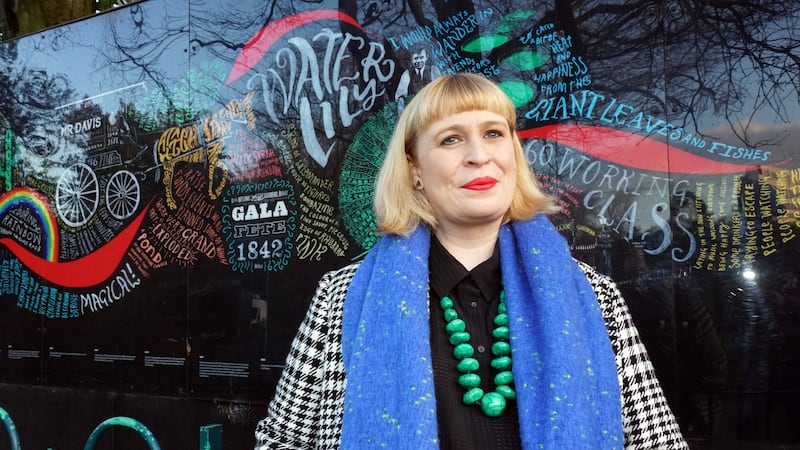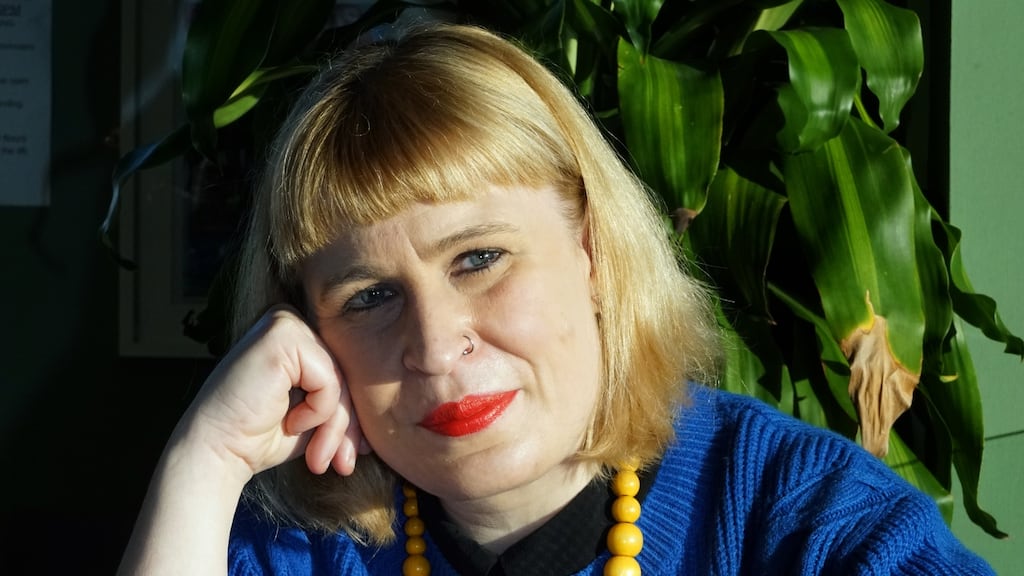A few months ago Jan Carson shared on her Twitter account a photo of a framed cheque, made out for the grand sum of $3. “I was living in the States at the time and I took it to the bank to get cashed, and it was going to cost $2.50 to cash it!” she laughs.
And so the cheque remained uncashed and now serves as a memento: it was payment for her first published short story in 2007. “Writing’s a long game, folks,” she added to the tweet. “Don’t be rushing.”
And here we are, 15 years later, as Carson is about to publish her seventh book and third novel, The Raptures. We meet in Jack’s coffee shop in east Belfast, where most of the book was written. “At that table over there,” she says, pointing. “My table! The wobbly one with the serviette stuck under the leg.”
She doesn’t, I take it, require silence and solitude to write? “I’m like that for non-fiction – essays and articles,” she agrees. But for fiction, “it’s a bit like how painters need to look at the thing they’re painting. I need to look up and see people moving, how their faces go when they’re concentrating.”
The process seems to have worked for The Raptures, which is full of realistic characters that the reader comes to love – and hate. “Before I began, I wrote short stories for each of the characters in the novel. So I’d already done all the character development for them.”
The novel, praised ahead of publication by Marian Keyes, is set in the fictional rural Northern Irish town of Ballylack in the early 1990s and has an intriguing concept. The children of the town – a religious, Protestant community – begin dying of an unexplained condition, which drives parents to distraction with anxiety, attracts media attention and isolates the one girl who appears unaffected.
That girl, Hannah Adger, is the moral centre of the story, along with her grandfather Pete. In a book full of surprises, it’s hard to reveal much about what happens, but the novel takes in family crises, religious and social paralysis, smuggling, wracking guilt and conversations with dead children. It sounds grim but surprisingly – or not for those who are familiar with Carson’s work – it’s funny, particularly when the dead children take the stage.
“I can’t really write any other way!” says Carson. “I can try to write deadly serious stuff, [but] it doesn’t come out of me right, it sounds forced. There’s always a bent towards humour and a bent towards the fantastical as well, but it has to be grounded in something quite solid. I can’t see myself writing a slapstick novel or a fantasy novel.”
That brings us to another feature in Carson’s novels: how she blends real life and fantastical elements. Her acclaimed 2019 novel The Fire Starters, set in modern Northern Ireland, features mythical children, a siren, and – having softened the reader up to the strange lurking inside the everyday – traditional Belfast bonfires, straddling a line between the quotidian and the weird.
There's a lot of books about women who go against the system – but the majority of women are stuck within the system. They're in a small, quiet way trying to change it from the inside.
Similarly, The Raptures is driven by tension between the mystery of what might be causing the children to die – a curse, dark magic, or something more mundane? – and what is really happening. (Any resemblance to a real pandemic is, by the way, coincidental. The book was written almost three years ago.) Northern Ireland is, as Carson comments, a paradox: a place “steeped in religion, where folks can be quite comfortable with the miraculous, but not comfortable at all with magic or folklore, particularly in the Protestant community”.
For example, “the church I grew up in was cessationist, so they believe the age of miracles ended with the New Testament. But I came across all of these elders who were practising curers – they were rubbing potatoes on things and burying them in the garden! As strict Presbyterians they would reject religious miracles but use cures. So there’s this really strange interplay in the North between those things, and I want [The Raptures] to be deliberately ambiguous: what on earth is going on here?”

Indeed The Raptures is close to Carson’s own upbringing near Ballymena. In the acknowledgements she describes it as “the book I’ve been trying to write for 20 years”. What did she mean? “It’s really close to home. This is right on my doorstep where I grew up. I think writing about the world of your childhood and the community that you belong to is probably the hardest thing to do”.
It’s a balanced portrait, with the good, the bad and lots of grey in between. One of the most striking characters is Alan Gardiner, who appears deeply unsympathetic; for example, he admits to himself that he doesn’t love his own mixed-race son. “I didn’t want him to be a flat stock character,” explains Carson. He’s an example of “that thing in Northern Ireland of these people who are desperately, desperately screwed up. But they’ve come from a long line of people who didn’t expose them to anything open-minded or challenging”.
There’s an expectation, she says, that the next generation will make everything right. But “they’ve never seen anything outside of here. They’re just going to do the same thing over”. This is one reason why the book is set in the early 1990s. “I set it in ’93 because if something happens after the internet, there’s slightly less excuse for kids to be blinkered because they have this portal into other communities. But in Ballymena in 1993, unless you had parents who were taking you somewhere else, you weren’t seeing anything except what was happening in the three miles around you.”
Another political facet of the book Carson hopes people will engage with is that “to me, it’s a feminist text. It’s about how women are treated within these conservative religious environments. And this happens to be evangelical Protestantism, but it’s just as pertinent to Muslim communities, Catholic communities, Hasidic Jewish communities”. In The Raptures Hannah and her mother struggle against the status quo.
“I spent a lot of time thinking about how you write those characters that are aspirational for women but are also believable. There’s a lot of books about women who go against the system – but the majority of women are stuck within the system. They’re in a small, quiet way trying to change it from the inside. So I hope some of that comes out.”
‘It will change’
Carson is now part of a growing community of women fiction writers in and from east Belfast, including Lucy Caldwell and Wendy Erskine. The cafe we’re sitting in is next to CS Lewis Square, which is scattered with statues of Narnia characters, though Carson admits quietly “I don’t really like CS Lewis’s work that much”. But “I think he’s one of the most marketable things we have in Northern Ireland, because he’s internationally known”.
Yet, as Carson has pointed out on her Twitter account, modern writers from the North seem to struggle to be recognised in some Irish outlets; a recent essay in the Dublin Review of Books on books by young Irish women had no mention of northern writers. “It’s like, how can you not notice what’s going on up here?” asks Carson. “In the next year, there’s [The Raptures], there’s Lucy Caldwell, Wendy [Erskine], Bernie McGill. And then there’s Michelle Gallen, Louise Kennedy, Olivia Fitzsimons… Hopefully if we keep pointing it out, it will change, because it’s their loss.”
The Raptures is the third book Carson has published since the start of the pandemic, following her collection of flash fiction, Postcard Stories 2, and her short stories, The Last Resort. She’s also active in the local community as an arts facilitator. Might it seem unjust to ask what’s next?
“I’m knackered!” she says. “I need a circuit breaker. Forty years ago you could be a writer and just write books. Now there’s this expectation of the persona of the writer. That’s exhausting. I had a piece on Radio 3 on Monday, I had two strangers coming up to me in the street – one of them cried!” But Carson says she has, among other things, “another novel” written, a project on “how dementia is depicted in fiction”, and she’s editing an anthology of short stories coming from New Island this year. So yes, she can have a break. But not, we hope, for too long.











